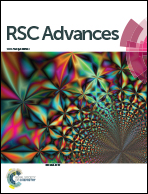Three-dimensional TiO2@C nano-network with high porosity as a highly efficient Pt-based catalyst support for methanol electrooxidation†
Abstract
The development of highly active and durable Pt-based catalysts is an important issue for methanol electrooxidation. Research into highly efficient supports provides a feasible method to achieve such catalysts. In this paper, carbon-coated TiO2 nanowires with a unique three-dimensional network structure are prepared as a Pt-based catalyst support by the carbonization of a resorcinol–formaldehyde polymer. Physical characterization confirms that this unique structure can provide a large specific surface area, high porosity and efficient transport channels. The abundant heterogeneous interfaces between the TiO2 nanowires and carbon provide numerous Pt loading sites, which greatly improves the utilization of Pt. Strikingly, electrochemical measurements show that the as-prepared catalyst has much better activity and durability than commercial Pt/C for methanol electrooxidation. Furthermore, the single direct methanol fuel cell test demonstrates that the as-prepared catalyst has higher power density and polarization current. We attribute this excellent catalytic performance to the unique nano-network structure, the numerous Pt anchoring sites, and the synergetic effect of the different components.


 Please wait while we load your content...
Please wait while we load your content...